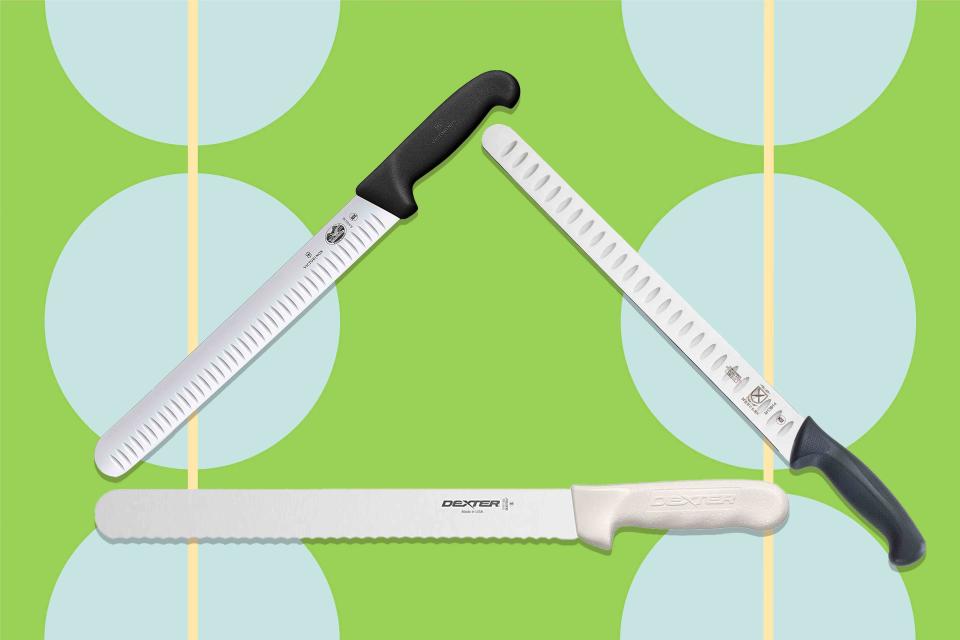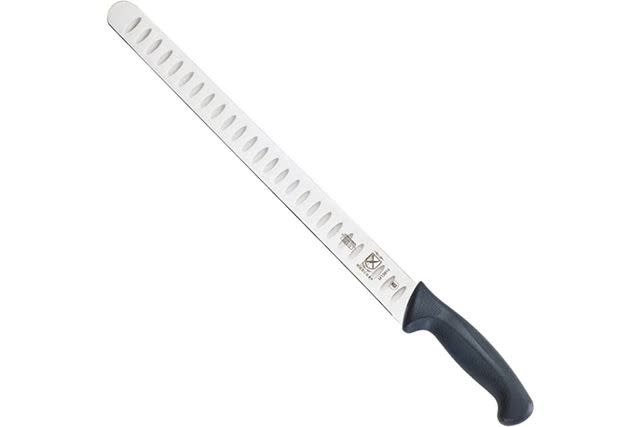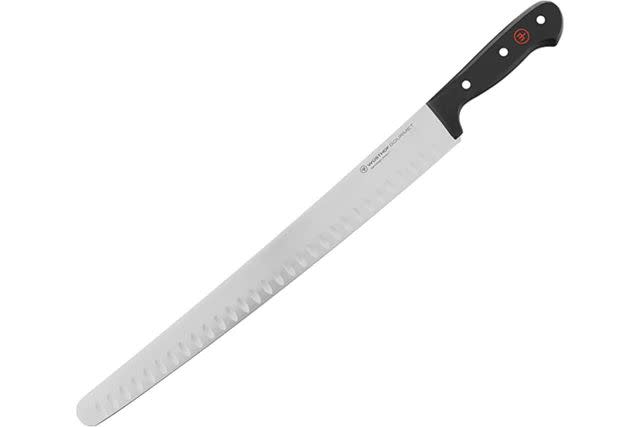The 6 Best Knives For Slicing Brisket, According to BBQ Experts
Dotdash Meredith and Yahoo Inc. may earn commission or revenue on some items through the links below.
The Victorinox Fibrox Pro Granton Edge 12-Inch Slicing Knife is our top pick.

Food & Wine / Jaclyn Mastropasqua
When you’ve invested the time to cook a delicious brisket, the last thing you want is to end up tearing it to bits during the slicing process. While a good chef’s knife is an essential component of any kitchen, when it comes to slicing a slab of perfectly smoked meat, it’s worth reaching for just the right tool for the job.
And sure, if preparing a brisket is something that only occasionally happens in your household, you probably don’t need to buy a specialty tool, but a good brisket knife doesn’t have to cost an arm and a leg. The best brisket knives will feel comfortable in your hand and feature an ultra-sharp blade to help you make clean, even slices without crushing or tearing the meat you’ve waited so patiently for. Below, we’ve assembled the best brisket knives in the biz, so let’s get to slicing.
Victorinox Fibrox Pro Slicing Knife with Granton Blade
Best Overall

Pros: This is an affordable, effective brisket knife that offers a great grip.
Cons: Pricing varies across retailers.
“My favorite brisket knife would be a 12-inch scalloped or serrated slicing knife,” says Greg Peters, executive chef at Houston’s Georgia James Steakhouse, adding that he “prefers the Victorinox brand for the majority of my butcher knives.”
The long, ultra-sharp, semi-flexible blade of the Victorinox Granton knife allows for precise cuts with minimal effort — exactly what you want for a unique slab of meat like brisket.
Chef Chris Huerta of Old Edwards Inn & Spa in Highlands, North Carolina, agrees, explaining that after putting more than 48 hours into each of his briskets, “the last thing we would want is to tear up such a delicacy with the wrong knife. The serrated edge of the Victorinox Granton Edge Slicer allows you to saw, but with just the right amount of precision.”
While the pricing of this knife varies quite a bit between retailers, it can be had for around $50, which is an outstanding value for a knife of this caliber.
Price at time of publish: $52
Size: 17.38 inches
Blade type: Granton
Mercer Culinary Millennia 14-Inch Slicer
Best Value

Pros: A quality slicing knife at an affordable price.
Cons: It’s not drastically less expensive than some competitors.
We like the Mercer Culinary Millennia for its pocketed, sharp blade at a budget-friendly price. The brand is known for producing excellent-quality knives that are affordable, and you’ll have real versatility with this 14-inch blade. It’s great for brisket, whole hams, turkey — basically anything you’ll want to slice with deftness and accuracy.
Though 14 inches may sound unnecessarily long, this knife is well-balanced, with a grippy handle that inspires confidence and won’t fatigue your forearm before you’ve made it halfway through your brisket.
Price at time of publish: $35
Size: 19 inches
Blade type: Granton
Wüsthof Gourmet 14-Inch Hollow Edge Brisket Knife
Best Splurge

Pros: A top-performing brisket knife recommended by the pros.
Cons: Yep, it’s pricey.
“My favorite knife is the Wüsthof Gourmet 14-Inch Brisket Slicer,” says Daniel P. Craig, chef and founder of Kitchen Deets. “What I really like about this knife is that it’s designed to make clean, precise cuts through the large and tough cut of meat, making it easy to slice brisket into thin, even slices.”
Craig also cites the Wüsthof’s flexible blade as an advantage for maneuvering while slicing, which helps avoid damaging the meat (or your fingers).
Wüsthof knives often appear on our lists of the best knives for various uses, and with good reason: the German brand has been crafting quality blades since 1814.
Price at time of publish: $170
Size: 19.36 inches
Blade type: Granton
Dexter-Russell 12-inch Slicer
Best for Beginners

Pros: This serrated blade may feel more familiar than those with hollowed edges.
Cons: The flexible blade might take some getting used to.
With a price point that rivals our “best budget” pick, the Dexter-Russell slicer is a great place to start if you’re just beginning your brisket journey and aren’t quite ready to invest in the likes of a Wüsthof slicer. This blade lacks the hollow pockets found on the knives we’ve selected above, which may feel more familiar to first-time users as this knife looks a lot like a standard bread knife.
Use it, though, and you’ll notice the sharp serrations and blade flexibility are capable of tackling far more than just a freshly baked sourdough.
Price at time of publish: $33
Size: 18.8 inches
Blade type: Serrated
Hamilton Beach Electric Knife
Best Electric

Pros: This knife makes quick work of carving at a surprisingly low price.
Cons: Not as precise as slicing with a conventional blade.
Electric carving knives may seem like a relic of the past, but they’re still out there and are performing better than ever. Hamilton Beach makes this surprisingly affordable option, which even includes a fork and storage case. The reciprocating serrated blades work quickly and efficiently to slice through brisket, turkey, or just about anything else you can throw underneath.
The cuts may not be quite as precise as those made with a sharpened conventional blade, but an electric carving knife is a great option if you’re pressed for time or have challenges with gripping a knife for extended periods of time.
Price at time of publish: $26
Size: 17 inches
Blade type: Reciprocating serrated
Victorinox Fibrox Curved Boning Knife
Best for Trimming

Pros: A sharp and purposeful knife at a great price.
Cons: Not ideal for running double-duty as a slicer.
When you’re trimming a brisket, a 12- or 14-inch blade can be unwieldy, so we prefer a boning knife. This one from Victorinox clocks in at a great price, and the curvature of the sharp blade is perfect for maneuvering around a brisket’s fat cap.
Due to the conservative blade length, unfortunately, you won’t be able to use a boning knife as your brisket slicer after the meat is ready — or, well, you could, but it won’t be easy — but at this price, why not keep one on hand?
Price at time of publish: $23
Size: 11.25 inches
Blade type: Standard edge
Our Favorite
The Victorinox Fibrox Pro Granton Edge 12-Inch Slicing Knife is our choice for best overall thanks to its reasonable price and expert-recommended performance. For a splurge, the Wüsthof Gourmet 14-Inch Hollow Edge Brisket Knife won’t let you down.
Factors to Consider
Blade type
Though largely a matter of personal preference, the Victorinox and Wüsthof knives that come most heavily recommended by experts feature a Granton blade. This means there are small hollows in the blade, which create tiny pockets of air between the blade and the meat. This helps stop the meat from sticking and tearing.
Serrated blades offer effective traction as the scalloped edges “bite” into the meat, allowing for quick cuts. In either case, a sharp blade is the best blade.
Manual versus electric
An electric brisket knife is useful if you suffer from carpal tunnel or otherwise struggle to grip a knife for extended periods of slicing. Electric knives can be faster, but they’re not always as precise as manually slicing brisket.
Balance
Brisket knives tend to be lightweight thanks to the slim, flexible blade, but like any good chef’s knife, it’s important that a knife feels balanced in your hand. This helps with both the performance of your knife and keeping your hands and fingers safe.
Frequently Asked Questions
How do you slice a brisket?
“It’s important to slice against the grain of the meat,” says Peters. “Slicing against the grain is interesting with a brisket because there are two parts to the meat: the flat and the point.” Peters recommends slicing the brisket in half between the two parts, then slicing the flat against the grain before rotating 90 degrees and slicing the point against the grain. “I usually cut about one quarter-inch slices,” he adds.
Why do I need a special knife to slice brisket?
As Huerta noted, brisket takes time! You don’t want to mess up a beautiful cut of meat by hacking into it with an unfit knife. A long, sharp blade with some flex will give you the most control when slicing up a brisket.
What’s the difference between a slicing and a carving knife?
Typically, carving knives have a blade that tapers to a point, whereas slicing knives maintain their width all the way down to the rounded tip. Carving knives are a bit easier to maneuver around joints and cartilage, while slicing knives allow for more delicate, even cuts.
Our Expertise
This article was written by Summer Rylander, a food and travel journalist who has written about food, beverage, and cooking products for Food & Wine, Allrecipes, Serious Eats, and The Kitchn. She made her selections based on in-depth research and conversation with chefs and pitmasters who are familiar with preparation — and subsequent slicing — of brisket.

